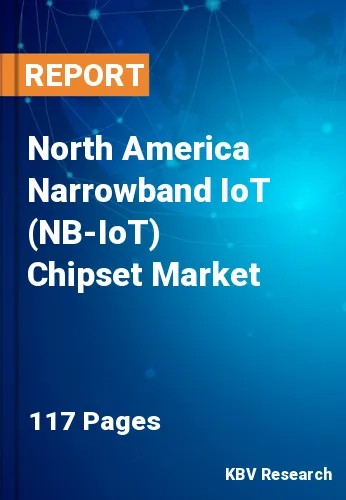The North America Narrowband IoT (NB-IoT) Chipset Market would witness market growth of 51.0% CAGR during the forecast period (2022-2028).
The fact that NB-IoT is half-duplex means that it effectively supports uplink communication, which includes establishing a connection to the cellular network, and allocating network resources to the node (also referred to as User Equipment, or UE), and transmitting data.
Specific indoor coverage, long battery life, low cost, as well as high connection density are the main focuses of NB-IoT. A portion of the LTE standard is used by NB-IoT, but the available bandwidth is only 200 kHz wide. For uplink and downlink communication, it employs SC-FDMA and OFDM modulation, respectively. Applications for the Internet of Things (IoT) that call for more frequent communications would be better serviced by NB-IoT, which operates on the licensed spectrum with no duty cycle restrictions. Up to 50,000 devices can be connected effectively with NB-IoT, which also minimizes power consumption and extends coverage to areas that are not currently covered by traditional cellular technologies.
Due to its narrowband specification and additional 20dB of signal amplification over the GPRS signal, Narrowband IoT allows a large range of connections for each base station and offers deep indoor penetration. Because of all of this, the modules purportedly have a battery life of up to 10 years and have low power usage. It is also considerably less expensive than alternative M2M/IoT solutions.
In Canada, the largest provincial operation is by far the healthcare sector. According to Ontario's Ministry of Health, over 40% of government spending in the fiscal year 2015–16 went toward healthcare. The country's financial viability depends on regulating the growth of this spending due to an aging and increasing population. Reinvesting in patient care would be made possible by the reduced healthcare costs across the country. In addition, as per the United States Bureau of Labor Statistics healthcare occupations are expected to add around 2.6 million new employment between 2020 and 2030, growing at a substantially greater rate than the average for all occupations. More employment than any other occupational group is anticipated to be added in the healthcare sector.
The US market dominated the North America Narrowband IoT (NB-IoT) Chipset Market by Country in 2021, and would continue to be a dominant market till 2028; thereby, achieving a market value of $1,555.6 million by 2028. The Canada market is estimated to grow at a CAGR of 54.4% during (2022 - 2028). Additionally, The Mexico market would showcase a CAGR of 53% during (2022 - 2028).
Based on Application, the market is segmented into Alarms & Detectors, Smart Meters, Trackers, Wearable Devices, Smart Parking, and Others. Based on Deployment, the market is segmented into Guard, In-band, and Stand-alone. Based on Offering, the market is segmented into Hardware (Processor, Memory, and Power Management Unit) and Software. Based on Vertical, the market is segmented into Infrastructure, Energy & Utilities, Automotive & Transportation, Agriculture, Healthcare & Dental, and Others. Based on countries, the market is segmented into U.S., Mexico, Canada, and Rest of North America.
Free Valuable Insights: The Global Narrowband IoT (NB-IoT) Chipset Market is Estimated to reach $7.7 Billion by 2028, at a CAGR of 51.6%
The market research report covers the analysis of key stake holders of the market. Key companies profiled in the report include Samsung Electronics Co., Ltd., Intel Corporation, U-blox Holding AG, Sequans Communications S.A., Huawei Technologies Co. Ltd., Qualcomm, Inc., Nordic Semiconductor ASA, MediaTek, Inc., Sercomm Corporation and Sanechips Technology Co., Ltd
By Application
By Deployment
By Offering
By Vertical
By Country
Our team of dedicated experts can provide you with attractive expansion opportunities for your business.

